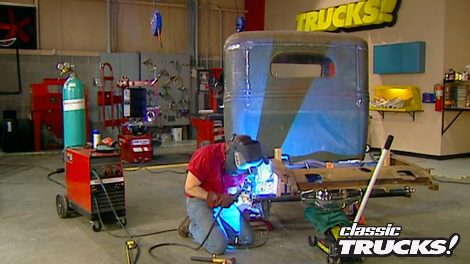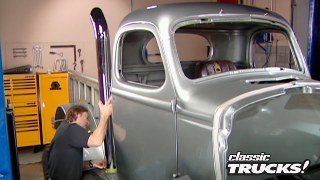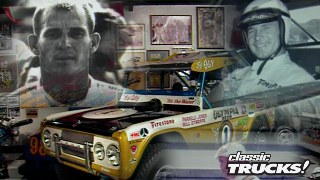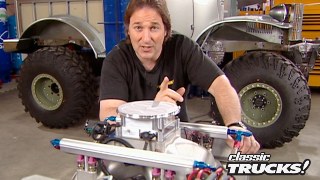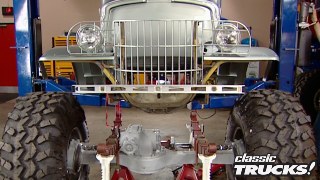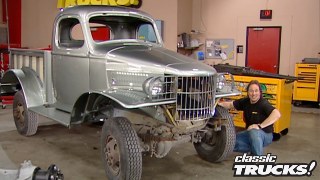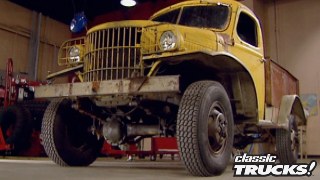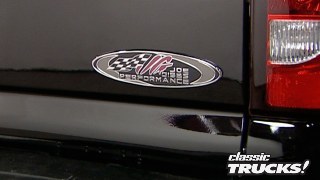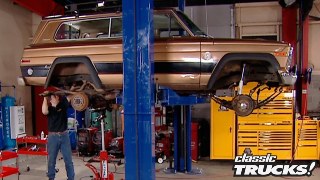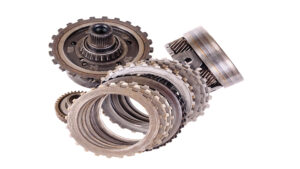Classic Trucks! Builds
Want more content like this?
Join the PowerNation Email NewsletterVideo Transcript
You know, wherever we go, people are always asking about all these wild projects that I'm always building here on trucks. You've got Copperhead and Crazy Horse and the Wicked Willies and the Tomb raider Jeep.
And that's cool because that's what this show is all about to hopefully encourage you to go out and build yourself something like that.
Now, one project that people are always asking about
is the Hairy Hauler. What happened to it? Where did it go? Is it done? What is up with it?
Well, you can relax because no, no, you haven't missed
it. It's just been patiently waiting its turn and today is its turn under the knife because we're gonna talk about four links, four bars and ladder bar systems. But first
let me to remind you of what the Hairy Hauler really is.
The hauler started out as a 1934 international that was gutted and put out to pasture in a field in Nebraska.
Surprisingly, the body was in excellent shape, which made it perfect hot rod material.
The first thing we did was disassemble the front end
and in its place, installed a state of the art heights independent front suspension with this brakes for drivability. But we kept the look of an old sixties Gasser with the right wheel and tire combination.
The rear end was up next with a four bar suspension and a nineties Ford rear end.
And we'll talk about that a little more later on.
Now, all along, I knew the windows were too tall, especially for a vintage style hot rod. So the next step was to prep up the cab
through the window in an area where this top piece and the bottom piece are the most vertical of each other
and then unmercifully whack three inches out of the top.
Of course, there's a little more to chop on the top than just the roof. There's the doors and the windows to deal with, but
all this work is definitely worth it.
Now slide the piece into place, make sure everything's lining up,
cut out a piece weld this in
with all that done. It was time to move on to the bed
and the old one was way too rough to mess with.
So we picked up a replacement from pro's pick and it not only bolted right into place, but it also included the wood and the tailgate
and then slide our lens through the opening
metal work was the name of the game. As we dug into the frame, knocking out cross members, welding up holes and boxing the frame to make it strong.
Then it was back to the body to fabricate an inner structure for the cab and the floor
and then finally cover that new floor structure with new sheet metal
and locate the steering column and pedals.
The outside of the cab needed some new metal too as the years had definitely taken their toll. So replacement panels were fabricated
and they carefully welded into place.
At
this point, the chassis was all done. It was packed in a hot small block, Chevy, I painted everything up nice. All the detail work was done. All it needed was the body and the body just needed paint.
But then the project took on a new twist because
I built this 1955 331.
Hemi
Yeah, it's got a Hammy
in it.
It doesn't get more vintage hot rod than this,
but this isn't just a bunch of old technology. No, this is new parts like these aluminum heads and billet roller rockers from hotheads.
Of course, up on top is a Hill Born eight stack fuel injection,
but it's been converted to electronic fuel injection by Blower Drive service.
This is the Taylor Vertex Magneto, but inside is an HE I distributor, which means this looks like 1961 but it runs like today.
So this engine had to go in this truck. So I put it in which brings me up to today's project.
Of course, everybody knows the whole reason for modifying your truck is change. You're changing it to make it better and faster and a little cooler. And it doesn't matter if this is the first time that you've torn into your truck or if it's the 10th time you're working on it.
There is one general rule that you really need to remember. You need to design the project. So all the parts work together and fit the way you're gonna drive the truck. For example,
when I put this hemi
in here, obviously, I had to change the motor mounts,
but add that engine
to that six speed manual transmission
throw in some very sticky 18 inch wide, Mickey Thompsons and of course, my heavy right foot
and I've got a rear end that I'm gonna have to upgrade if I don't want to end up in the wall when I take this thing down the drag strip. So that means I need a four length back here and I'm gonna show you how to put one of those in right after the break.
Hey, welcome back to trucks where I'm just about ready to install an art Morrison four link rear suspension in the Hairy Hauler here where there was once
a four bar. Now, I know a lot of you are probably thinking,
whoa wait, stop four link four bar. What in the heck are you talking about?
It's obviously pretty important because
you just tore apart a really nice chassis to put it in. So what's up?
Well, good questions. Come on over here. Let's see if we can shed some light on the difference of these suspension systems.
Now, the first thing we're gonna take a look at is a four bar system
or in this case, just half of one.
Now, basically what you've got is two parallel bars that run down both sides of the frame rail,
got the axle that welds in here, cross member that welds here
and this basically holds your axle in place. Now, the four bar was primarily designed for street use. So this will give you a great ride on the street.
It's also very small, so it tucks into tight areas.
And the reason for the two bars is that when that axle moves up and down,
your opinion angle doesn't change. This is great for airbag systems.
Now, the cons to a four bar, well, it's not adjustable.
It doesn't give you the best traction off the line.
And the real biggie is, it's not as strong as a four link or a ladder bar system. So if you're running over 450 horsepower and you're getting on it,
you're probably gonna bend some brackets or break a few things.
Now, this is a four link.
Now, it looks like a four bar gives you all the benefits of a four bar,
but this is completely adjustable both in the link bars themselves and in their mounting points appear on the bracket tree. So you can drive one of these things down the road, get a nice ride, take it to the drag strip, move some of these bars around
and this sucker will hook up like nothing you've ever seen. Now, also notice that the bars connect above
and below the axle,
the axle comes through the bracketry. So you get a nice solid weld all the way around. A
four link is considerably stronger than a four bar.
Now, the downsides, well,
obviously a four link is considerably bigger than a four bar.
So it may or may not fit your application. Also, it's a little tougher to put in. But don't worry, we're gonna show you how to do that. But first, let's take a look at the kit.
This is from Art Morrison Enterprises and of course, it includes the four length bars and all the bracketry.
Then you've got a new cross member with the drive shaft tube then to strengthen the frame, you have these inner frame rails and of course a bunch of braces for that.
Now, it's usually the case. Anytime you're doing chassis fabrication,
you're not gonna find anything that just pops right into place,
you gotta make it fit. We're gonna show you how to do that.
Now, for the rear end, we went to Curry Enterprises got one of their super strong nine inch housings
because it'll handle the abuse that we're gonna throw at it.
Now, one of the good things about using somebody like Art Morrison is that if you've got your measurements and all your dimensions,
they will weld on the bracketry for your four L
and your shocks. That'll save you some time. Now, we're gonna take a break when we come back,
we're gonna start putting this in.
Welcome back to trucks
today. We're taking a look at how to install a four link suspension into the rear of your hot rod truck. And I'm using a universal kit from Art Morrison Enterprises. Now, the first thing I did while you were away at break is weld these brackets to the new cross member.
And now
it's time for that cross member to go in which means it's time to measure.
Ok? According to the specs that came with the new four link system that cross member needs to mount 26 inches in front of the axle center line.
So obviously, you need to know where your axle is gonna mount and that is what this is. Now, I made this mark with eight inch masking tape before I took the old axle out.
Having this mark is very important because everything else is gonna come off of that measurement
with the cross member tacked in place, double and triple, check your measurements
and then go ahead and weld it in
the next area that we're gonna add some strength to is the frame
to keep it from flexing and twisting on us too much when we start jumping on that
hemi. Now, for that we got these inner frame rails made out of nice thick square tubing.
All you gotta do is set them in place.
Markham,
cut them
and weld them in.
Now with everything welded in place, you're probably getting a better idea. Just exactly what we're doing here.
It's kind of hard to visualize this when it's all a big pile of metal over there on the table. Now, as you can see, we have added some serious strength here and man, it looks good too.
Now with a four link, you have got tremendous pressure coming in at the bottom of this bracket because when you accelerate
that rear end wants to rotate up, that puts all that pressure on that lower link bar.
So to keep this from bending,
that is what this tubing is for.
Now, it welds right here to the bottom of the bracket
and then you can bring it out, weld it to the lower frame rail or if you have enough room,
you can weld it to these new inner frames, whichever way you want to do it is up to you. But once you decide all you have to do is cut it
and weld that boy in.
Well, there it is a four link system
and you can see how this is all fitting together now that we've got the bars and the housing and the shocks in place.
Now, I know it seemed like this one together really easy, but don't be fooled. This is gonna peg out our difficulty meter because there's a lot of precision cutting and welding and fabricating involved in a project like this. So be prepared but not scared because as you can see
the results are definitely worth it.
One scenario that everybody can relate to is truck on the side of the road hood is up, steam blowing up out of the radiator driver on the cell phone
inside calling for help.
Yeah, some of you have been that driver.
That's because very few people understand the cooling system
and that's what we're gonna change because we're gonna show you how it works,
how it works is brought to you by Wyotech.
All right, Paul, we're gonna take the viewers through a basic cooling system for the next 2.5 minutes.
You get to go first. Ok. Well, like I said, we're gonna start with the cooling system, probably one of the most important systems on our automobile today. Absolutely. Absolutely. What are we looking at first? Well, we're gonna start right here at the water pump first, the heart of the system. Ok. That rotates off of pulleys and belts that gives us our flow. And then what happens? We're gonna take that flow and we're gonna bring it right over here to our cooling jackets. Ok. Now, once that coolant enters the block,
what's it doing
as the coolant enters? It's gonna come through and go by each and every cylinder and as it does that it's going to absorb the heat that's caused by extreme temperature in our combustion chamber.
Ok. Then it flows up into the head.
And what happens does the exact same thing flows through the head absorbs all the heat that it can.
And now we're gonna stop right here at our thermostat housing. All right. The thermostat. We've all heard about the thermostat and the old wives tails. Yeah. Take that thermostat out in the summertime. It'll run cooler.
What do you think of that? Just like you said, it's an old wives tale has actually the control for our cooling system and by taking that out you're gonna cause yourself some havoc. Ok? You got your outlets for your heater. Of course, the water pump continues to flow that way comes out to your heater core. All right, maintenance. Ok. We've all heard about the cooling system needing to be flushed. Radiator need to be flushed. Why?
Well, like I said before, it's probably one of our most important systems, but it's probably one of the most neglected systems.
Uh, it's neglected and as the coolant comes through and absorbs the heat,
it's gonna pick up, scale and build up and the more it does that the less flow it gets. So we're trying to do some preventative maintenance there and make sure that we have good flow throughout our system. Ok. Now, the exits out here to the radiator. Now, most people are familiar with the way a radiator works, how it dissipates heat,
but a lot of people have no idea how the pressure cap works. Paul, what about it?
Just like you said, it actually applies pressure to the liquid itself
and by applying pressure to it for every one pound of pressure that you put on it, it raises the boiling point by three degrees. And how about cool its, what do you recommend
whatever the vehicle came with or the manufacturer specified for it? That's what I recommend.
It came with green or pink. It doesn't matter, stick with it because you start crossing them, the molecular structure is completely different and it's gonna cause you havoc down the road again. All right, good. Well, hopefully that gives you an idea what's going on in the cooling system. So the next time you're sitting in traffic, summer day, air conditioning on
and that temperature gauge is right where it's supposed to be
now, you know how it works.
If you're looking for a tough rugged four wheel drive truck,
well, everybody knows that the Ford super duty is hard to beat,
but if you've got one and you wanna make it a little tougher off road like this.
Well, first thing you need to do is lift it, get it up in the air and this is the kit to do that. It's from skyjacker and they call it the Z link coil over conversion. Yeah, you heard me right.
This basically converts your stock leaf spring front suspension
to a four L
with coil over shocks. And you can get this in a six inch lift or an eight inch lift. And of course, you've got all the bracketry to put it in. But believe it or not, you only have to drill eight holes to install this.
Now to get the rear of the truck up where it needs to be.
Skyjacker also has the soft r
leaf springs. Now take a look at how nicely this all goes together under the front of this Ford.
You got the upper link coming back from the front,
the coil over shock is on top of the axle
and then the lower link goes to the rear. This is an awesome suspension.
The really big surprise here though is this is a bolt in kit
that gives you greater suspension travel and a better ride than your stock leaf springs
and it looks really good too. So if you've got a Ford Super duty,
you need to call Skyjacker because you need this kit.
Since we're on the subject of lifted trucks, I have a tire, I wanna show you.
This is new from inner co tire and it's called the TRX this mud terrain. And this has a tough, very aggressive tread with a lot of sipping in. It
makes it great for mud and rocks and wet conditions.
But since it is also a radio it's surprisingly smooth and quiet on a highway. This is a great tire for those of you that like to drive your truck every day through the week and then take it out and play with it on the weekend. Now, since we're on the subject of tires, got a wheel, I wanna show you
this is from Weld racing and they call it the mountain crusher. Now with a name like that, you'd better be strong. Right. Right. Well, this one is, it's made out of super strong, forged aluminum,
but a wheel just can be strong. It's gotta look good too. So it's fully polished, has a unique spoke design
and then you've got the simulated bead lock running on the outer rim. So you not only have a tire that looks tough,
it is tough, especially if you wrap that rim
with that tire,
it would be a nice combination.
Show Full Transcript
And that's cool because that's what this show is all about to hopefully encourage you to go out and build yourself something like that.
Now, one project that people are always asking about
is the Hairy Hauler. What happened to it? Where did it go? Is it done? What is up with it?
Well, you can relax because no, no, you haven't missed
it. It's just been patiently waiting its turn and today is its turn under the knife because we're gonna talk about four links, four bars and ladder bar systems. But first
let me to remind you of what the Hairy Hauler really is.
The hauler started out as a 1934 international that was gutted and put out to pasture in a field in Nebraska.
Surprisingly, the body was in excellent shape, which made it perfect hot rod material.
The first thing we did was disassemble the front end
and in its place, installed a state of the art heights independent front suspension with this brakes for drivability. But we kept the look of an old sixties Gasser with the right wheel and tire combination.
The rear end was up next with a four bar suspension and a nineties Ford rear end.
And we'll talk about that a little more later on.
Now, all along, I knew the windows were too tall, especially for a vintage style hot rod. So the next step was to prep up the cab
through the window in an area where this top piece and the bottom piece are the most vertical of each other
and then unmercifully whack three inches out of the top.
Of course, there's a little more to chop on the top than just the roof. There's the doors and the windows to deal with, but
all this work is definitely worth it.
Now slide the piece into place, make sure everything's lining up,
cut out a piece weld this in
with all that done. It was time to move on to the bed
and the old one was way too rough to mess with.
So we picked up a replacement from pro's pick and it not only bolted right into place, but it also included the wood and the tailgate
and then slide our lens through the opening
metal work was the name of the game. As we dug into the frame, knocking out cross members, welding up holes and boxing the frame to make it strong.
Then it was back to the body to fabricate an inner structure for the cab and the floor
and then finally cover that new floor structure with new sheet metal
and locate the steering column and pedals.
The outside of the cab needed some new metal too as the years had definitely taken their toll. So replacement panels were fabricated
and they carefully welded into place.
At
this point, the chassis was all done. It was packed in a hot small block, Chevy, I painted everything up nice. All the detail work was done. All it needed was the body and the body just needed paint.
But then the project took on a new twist because
I built this 1955 331.
Hemi
Yeah, it's got a Hammy
in it.
It doesn't get more vintage hot rod than this,
but this isn't just a bunch of old technology. No, this is new parts like these aluminum heads and billet roller rockers from hotheads.
Of course, up on top is a Hill Born eight stack fuel injection,
but it's been converted to electronic fuel injection by Blower Drive service.
This is the Taylor Vertex Magneto, but inside is an HE I distributor, which means this looks like 1961 but it runs like today.
So this engine had to go in this truck. So I put it in which brings me up to today's project.
Of course, everybody knows the whole reason for modifying your truck is change. You're changing it to make it better and faster and a little cooler. And it doesn't matter if this is the first time that you've torn into your truck or if it's the 10th time you're working on it.
There is one general rule that you really need to remember. You need to design the project. So all the parts work together and fit the way you're gonna drive the truck. For example,
when I put this hemi
in here, obviously, I had to change the motor mounts,
but add that engine
to that six speed manual transmission
throw in some very sticky 18 inch wide, Mickey Thompsons and of course, my heavy right foot
and I've got a rear end that I'm gonna have to upgrade if I don't want to end up in the wall when I take this thing down the drag strip. So that means I need a four length back here and I'm gonna show you how to put one of those in right after the break.
Hey, welcome back to trucks where I'm just about ready to install an art Morrison four link rear suspension in the Hairy Hauler here where there was once
a four bar. Now, I know a lot of you are probably thinking,
whoa wait, stop four link four bar. What in the heck are you talking about?
It's obviously pretty important because
you just tore apart a really nice chassis to put it in. So what's up?
Well, good questions. Come on over here. Let's see if we can shed some light on the difference of these suspension systems.
Now, the first thing we're gonna take a look at is a four bar system
or in this case, just half of one.
Now, basically what you've got is two parallel bars that run down both sides of the frame rail,
got the axle that welds in here, cross member that welds here
and this basically holds your axle in place. Now, the four bar was primarily designed for street use. So this will give you a great ride on the street.
It's also very small, so it tucks into tight areas.
And the reason for the two bars is that when that axle moves up and down,
your opinion angle doesn't change. This is great for airbag systems.
Now, the cons to a four bar, well, it's not adjustable.
It doesn't give you the best traction off the line.
And the real biggie is, it's not as strong as a four link or a ladder bar system. So if you're running over 450 horsepower and you're getting on it,
you're probably gonna bend some brackets or break a few things.
Now, this is a four link.
Now, it looks like a four bar gives you all the benefits of a four bar,
but this is completely adjustable both in the link bars themselves and in their mounting points appear on the bracket tree. So you can drive one of these things down the road, get a nice ride, take it to the drag strip, move some of these bars around
and this sucker will hook up like nothing you've ever seen. Now, also notice that the bars connect above
and below the axle,
the axle comes through the bracketry. So you get a nice solid weld all the way around. A
four link is considerably stronger than a four bar.
Now, the downsides, well,
obviously a four link is considerably bigger than a four bar.
So it may or may not fit your application. Also, it's a little tougher to put in. But don't worry, we're gonna show you how to do that. But first, let's take a look at the kit.
This is from Art Morrison Enterprises and of course, it includes the four length bars and all the bracketry.
Then you've got a new cross member with the drive shaft tube then to strengthen the frame, you have these inner frame rails and of course a bunch of braces for that.
Now, it's usually the case. Anytime you're doing chassis fabrication,
you're not gonna find anything that just pops right into place,
you gotta make it fit. We're gonna show you how to do that.
Now, for the rear end, we went to Curry Enterprises got one of their super strong nine inch housings
because it'll handle the abuse that we're gonna throw at it.
Now, one of the good things about using somebody like Art Morrison is that if you've got your measurements and all your dimensions,
they will weld on the bracketry for your four L
and your shocks. That'll save you some time. Now, we're gonna take a break when we come back,
we're gonna start putting this in.
Welcome back to trucks
today. We're taking a look at how to install a four link suspension into the rear of your hot rod truck. And I'm using a universal kit from Art Morrison Enterprises. Now, the first thing I did while you were away at break is weld these brackets to the new cross member.
And now
it's time for that cross member to go in which means it's time to measure.
Ok? According to the specs that came with the new four link system that cross member needs to mount 26 inches in front of the axle center line.
So obviously, you need to know where your axle is gonna mount and that is what this is. Now, I made this mark with eight inch masking tape before I took the old axle out.
Having this mark is very important because everything else is gonna come off of that measurement
with the cross member tacked in place, double and triple, check your measurements
and then go ahead and weld it in
the next area that we're gonna add some strength to is the frame
to keep it from flexing and twisting on us too much when we start jumping on that
hemi. Now, for that we got these inner frame rails made out of nice thick square tubing.
All you gotta do is set them in place.
Markham,
cut them
and weld them in.
Now with everything welded in place, you're probably getting a better idea. Just exactly what we're doing here.
It's kind of hard to visualize this when it's all a big pile of metal over there on the table. Now, as you can see, we have added some serious strength here and man, it looks good too.
Now with a four link, you have got tremendous pressure coming in at the bottom of this bracket because when you accelerate
that rear end wants to rotate up, that puts all that pressure on that lower link bar.
So to keep this from bending,
that is what this tubing is for.
Now, it welds right here to the bottom of the bracket
and then you can bring it out, weld it to the lower frame rail or if you have enough room,
you can weld it to these new inner frames, whichever way you want to do it is up to you. But once you decide all you have to do is cut it
and weld that boy in.
Well, there it is a four link system
and you can see how this is all fitting together now that we've got the bars and the housing and the shocks in place.
Now, I know it seemed like this one together really easy, but don't be fooled. This is gonna peg out our difficulty meter because there's a lot of precision cutting and welding and fabricating involved in a project like this. So be prepared but not scared because as you can see
the results are definitely worth it.
One scenario that everybody can relate to is truck on the side of the road hood is up, steam blowing up out of the radiator driver on the cell phone
inside calling for help.
Yeah, some of you have been that driver.
That's because very few people understand the cooling system
and that's what we're gonna change because we're gonna show you how it works,
how it works is brought to you by Wyotech.
All right, Paul, we're gonna take the viewers through a basic cooling system for the next 2.5 minutes.
You get to go first. Ok. Well, like I said, we're gonna start with the cooling system, probably one of the most important systems on our automobile today. Absolutely. Absolutely. What are we looking at first? Well, we're gonna start right here at the water pump first, the heart of the system. Ok. That rotates off of pulleys and belts that gives us our flow. And then what happens? We're gonna take that flow and we're gonna bring it right over here to our cooling jackets. Ok. Now, once that coolant enters the block,
what's it doing
as the coolant enters? It's gonna come through and go by each and every cylinder and as it does that it's going to absorb the heat that's caused by extreme temperature in our combustion chamber.
Ok. Then it flows up into the head.
And what happens does the exact same thing flows through the head absorbs all the heat that it can.
And now we're gonna stop right here at our thermostat housing. All right. The thermostat. We've all heard about the thermostat and the old wives tails. Yeah. Take that thermostat out in the summertime. It'll run cooler.
What do you think of that? Just like you said, it's an old wives tale has actually the control for our cooling system and by taking that out you're gonna cause yourself some havoc. Ok? You got your outlets for your heater. Of course, the water pump continues to flow that way comes out to your heater core. All right, maintenance. Ok. We've all heard about the cooling system needing to be flushed. Radiator need to be flushed. Why?
Well, like I said before, it's probably one of our most important systems, but it's probably one of the most neglected systems.
Uh, it's neglected and as the coolant comes through and absorbs the heat,
it's gonna pick up, scale and build up and the more it does that the less flow it gets. So we're trying to do some preventative maintenance there and make sure that we have good flow throughout our system. Ok. Now, the exits out here to the radiator. Now, most people are familiar with the way a radiator works, how it dissipates heat,
but a lot of people have no idea how the pressure cap works. Paul, what about it?
Just like you said, it actually applies pressure to the liquid itself
and by applying pressure to it for every one pound of pressure that you put on it, it raises the boiling point by three degrees. And how about cool its, what do you recommend
whatever the vehicle came with or the manufacturer specified for it? That's what I recommend.
It came with green or pink. It doesn't matter, stick with it because you start crossing them, the molecular structure is completely different and it's gonna cause you havoc down the road again. All right, good. Well, hopefully that gives you an idea what's going on in the cooling system. So the next time you're sitting in traffic, summer day, air conditioning on
and that temperature gauge is right where it's supposed to be
now, you know how it works.
If you're looking for a tough rugged four wheel drive truck,
well, everybody knows that the Ford super duty is hard to beat,
but if you've got one and you wanna make it a little tougher off road like this.
Well, first thing you need to do is lift it, get it up in the air and this is the kit to do that. It's from skyjacker and they call it the Z link coil over conversion. Yeah, you heard me right.
This basically converts your stock leaf spring front suspension
to a four L
with coil over shocks. And you can get this in a six inch lift or an eight inch lift. And of course, you've got all the bracketry to put it in. But believe it or not, you only have to drill eight holes to install this.
Now to get the rear of the truck up where it needs to be.
Skyjacker also has the soft r
leaf springs. Now take a look at how nicely this all goes together under the front of this Ford.
You got the upper link coming back from the front,
the coil over shock is on top of the axle
and then the lower link goes to the rear. This is an awesome suspension.
The really big surprise here though is this is a bolt in kit
that gives you greater suspension travel and a better ride than your stock leaf springs
and it looks really good too. So if you've got a Ford Super duty,
you need to call Skyjacker because you need this kit.
Since we're on the subject of lifted trucks, I have a tire, I wanna show you.
This is new from inner co tire and it's called the TRX this mud terrain. And this has a tough, very aggressive tread with a lot of sipping in. It
makes it great for mud and rocks and wet conditions.
But since it is also a radio it's surprisingly smooth and quiet on a highway. This is a great tire for those of you that like to drive your truck every day through the week and then take it out and play with it on the weekend. Now, since we're on the subject of tires, got a wheel, I wanna show you
this is from Weld racing and they call it the mountain crusher. Now with a name like that, you'd better be strong. Right. Right. Well, this one is, it's made out of super strong, forged aluminum,
but a wheel just can be strong. It's gotta look good too. So it's fully polished, has a unique spoke design
and then you've got the simulated bead lock running on the outer rim. So you not only have a tire that looks tough,
it is tough, especially if you wrap that rim
with that tire,
it would be a nice combination.
